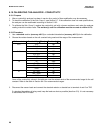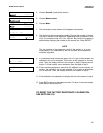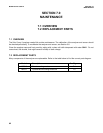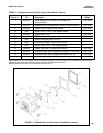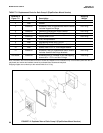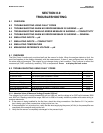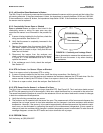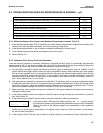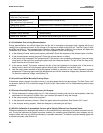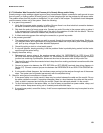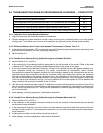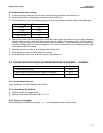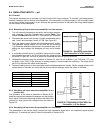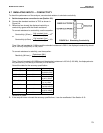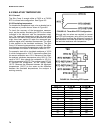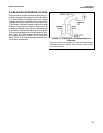
MODEL SOLU COMP II SECTION 8.0
TROUBLESHOOTING
8.3.3 Calibration Error during Standardization.
During standardization, the millivolt signal from the pH cell is increased or decreased until it agrees with the pH
reading from a referee instrument. A unit change in pH requires an offset of about 59 mV. The Solu Comp II limits
the offset to ±1400 mV. If the standardization causes an offset greater than ±1400 mV, the analyzer will display the
Calibration Error screen. The standardization will not be updated. Check the following:
A. Is the referee pH meter working and properly calibrated? Check the response of the referee sensor in buffers.
B. Is the process sensor working properly? Check the process sensor in buffers.
C. Is the sensor fully immersed in the process liquid? If the sensor is not completely submerged, it may be meas-
uring the pH of the liquid film covering the glass bulb and reference element. The pH of this film may be dif-
ferent from the pH of the bulk liquid.
D. Is the sensor fouled? The sensor measures the pH of the liquid adjacent to the glass bulb. If the sensor is
heavily fouled, the pH of liquid trapped against the bulb may be different from the bulk liquid.
E. Has the sensor been exposed to poisoning agents (sulfides or cyanides) or has it been exposed to extreme
temperature? Poisoning agents and high temperature can shift the reference voltage many hundred millivolts.
To check the reference voltage, see Section 8.9.
8.3.4 Invalid Input While Manually Entering Slope.
If the sensor slope is known from other sources, it can be entered directly into the analyzer. The Solu Comp II will
not accept a slope (at 25°C) outside the range 45 to 60 mV/pH. See section 8.3.2 for troubleshooting sensor slope
problems.
8.3.5 Sensor Does Not Respond to Known pH Changes.
A. Did the expected pH change really occur? If the process pH reading was not what was expected, check the
performance of the sensor in buffers. Also, use a second pH meter to verify the change.
B. Is the sensor properly wired to the analyzer?
C. Is the glass bulb cracked or broken? Check the glass electrode impedance. See Section 8.3.2, step f.
D. Is the analyzer working properly. Check the analyzer by simulating the pH input.
8.3.6 Buffer Calibration Is Acceptable, Process pH Is Slightly Different from Expected Value.
Differences between pH readings made with an on-line instrument and a laboratory or portable instrument are nor-
mal. The on-line instrument is subject to process variables, for example ground potentials, stray voltages, and ori-
entation effects that may not affect the laboratory or portable instrument. To make the process reading agree with
a referee instrument, see Section 6.5.
68
REFERENCE IMPEDANCE (Ref Imp)
less than 40 kΩ Normal reading, reference junction is clean.
(20 kΩ for TUpH sensors)
between 40 and 140 kΩ Reference junction is fouled or dirty.
(20 - 140 kΩ for TUpH sensors)
greater than 140 kΩ Reference junction is blocked or electrolyte is depleted. Sensor has failed.
GLASS IMPEDANCE (Glass Imp)
less than 10 MΩ Glass bulb is cracked or broken. Sensor has failed.
between 10 and 1000 MΩ Normal reading.
greater than 1000 MΩ pH sensor may be nearing the end of its service life.



